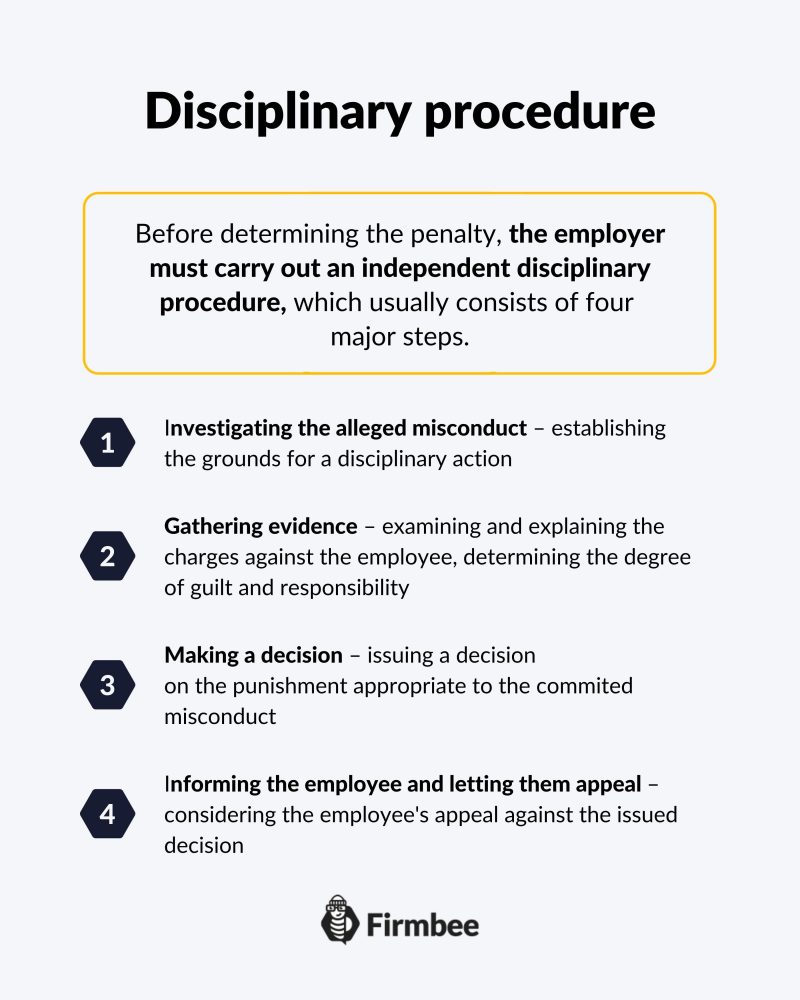What is employee accountability? When an employment relationship is established or a civil contract is signed between the employer and the employee, a mutual responsibility arises in relation to the provision of work. One party performs the assigned tasks and the other pays for them. Both an employer and an employee are responsible for compliance with labor law. The employer is accountable for providing the right conditions and tools for work, as well as for paying the salary on time. The employee, on the other hand, is responsible for the performed tasks and entrusted property. Read on.
Employee accountability – table of contents:
- What is employee accountability?
- Employee liability for maintenance of order
- Financial accountability
- Disciplinary accountability
- Summary
What is employee accountability?
Employee accountability relates to a set of negative personal and financial consequences incurred by the employee due to a failure to perform, or improper performance of duties stemming from the employment relationship. The scope of duties, whose negligence or non-performance entails certain restrictions, is regulated by the relevant national laws.The measures applied by the employer for the disorderly conduct of an employee are as follows:
- an admonition or a reprimand,
- the termination of employment without notice or due to employee’s fault,
- a financial penalty and deprivation of bonuses
Employees, within the scope of their duties, are held responsible for order, property and discipline in the workplace.
Employee liability for maintenance of order
Employee liability for maintenance of order refers mainly to observing rules and discipline at work, e.g., staff regulations, health and safety guidelines and fire safety regulations, as well as the accepted method of confirming the arrival and presence at work and excusing absences. An example of a rule violation may be leaving machines running unattended and abandoning work without prior information and permission.
A warning, a reprimand or a fine can be imposed on the employee for a violation of duties. However, before imposing the penalty, the employer is obliged to examine all the circumstances and listen to the employee’s explanations in order to determine the extent of liability.
The decision to impose a penalty should be made in writing, with information about the possibility to appeal. It is worth mentioning that a warning is an administrative penalty in Poland, while in Germany it is a necessary condition for the subsequent termination of the employment relationship.
Employee liability for maintenance of order performs the following functions: preventive, educational and repressive. Its preventive and educational function is aimed at motivating employees to observe rules and discipline at work, while its repressive function relies on punishing them.

Financial accountability
Employees who failed to perform their duties, either intentionally or unintentionally, can be held financially responsible for the damage caused to the employer as regulated by law. However, the degree of responsibility depends on the actual damage.
The employee is not liable for the damage if the employer or other parties contributed to it, and also if the employee acted within the limits of permissible risk. For example, if a police officer on duty loses their radio station, they are not liable for the lost equipment as they acted within the scope of acceptable risk.
If the damage is caused by several employees, each of them can be held accountable for it, depending on the degree of fault. If this is impossible to determine, the responsibility is borne jointly and equally. The employer is obliged to determine the circumstances justifying the employee’s fault.
Apart from its preventive, educational and repressive function, the financial liability also has a compensatory function. It is related to bearing the consequences of the damage by the employee in the form of financial compensation.
Disciplinary accountability
Disciplinary liability is determined by the employee’s fault with respect to the breach of duties and conduct inconsistent with professional ethics. The issue of discipline liability is extremely broad and is regulated in various ways depending on the country. However, the prerequisites of disciplinary accountability and the consequences associated with it are similar in most countries. Disciplinary accountability refers to:
- a severe breach of employee duties,
- a loss of authority (due to one’s own fault) required to perform work,
- committing a crime which makes it impossible to continue work at the current position.
The most popular disciplinary penalties are, for example, a reprimand, a deprivation of promotion opportunities, a reduction of job status and/or salary, and a dismissal from work. The penalty imposed by the employer should be relevant to the severity of the committed offense. Before determining the penalty, the employer must carry out an independent disciplinary procedure, which usually consists of four major steps:
- investigating the alleged misconduct – establishing the grounds for a disciplinary action
- gathering evidence – examining and explaining the charges against the employee, determining the degree of guilt and responsibility
- making a decision – issuing a decision on the punishment appropriate to the commited misconduct
- informing the employee and letting them appeal – considering the employee’s appeal against the issued decision
Formalized procedures based on binding legal regulations protect interests of both parties.
Summary
Employee accountability is not a uniform concept, and employee malpractice may involve various work-related issues. It is usually discussed in relation to compliance with work regulations and applicable laws, meeting deadlines, keeping company secrets, as well as taking care of the entrusted property.
Employers have a number of legal tools through which they can enforce employee accountability. However, they ought to do it in a responsible way, and with particular care when determining the circumstances of the alleged miscoduct and the degree of fault.
You’ve just learned what employee accountability is. Other resources: What is experiential learning?
If you like our content, join our busy bees community on Facebook, Twitter, LinkedIn, Instagram, YouTube, Pinterest.
Author: Nicole Mankin
HR manager with an excellent ability to build a positive atmosphere and create a valuable environment for employees. She loves to see the potential of talented people and mobilize them to develop.



















